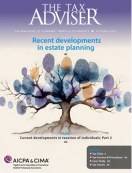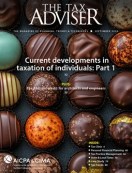- newsletter
- TAX INSIDER

Foreign-derived intangible income deduction: Tax reform’s overlooked new benefit for U.S. corporate exporters
The foreign-derived intangible income deduction provides C corporations that sell goods or services to foreign customers an effective 13.125% tax rate on qualifying income.
Please note: This item is from our archives and was published in 2018. It is provided for historical reference. The content may be out of date and links may no longer function.
Related
Stock-based compensation cost-sharing regs. valid
Amended Sec. 965 may provide a Sec. 382 benefit: Deemed repatriation and RBIG
How the 2017 tax overhaul changed Sec. 162(m)
P.L. 115-97, known as the Tax Cut and Jobs Act (TCJA), has ushered in numerous new tax rules and, for tax planners, new opportunities. One new opportunity is the foreign-derived intangible income (FDII) deduction in Sec. 250(a). For U.S. C corporations that sell goods and/or provide services to foreign customers, this deduction reduces the effective tax rate on qualifying income to 13.125%.
FDII is intended to operate in tandem with newly enacted Sec. 951A, which includes global intangible low-taxed income (GILTI) in the income of U.S. shareholders. GILTI is a new category of income for U.S. taxpayers owning a controlled foreign corporation (CFC). GILTI, similar to the existing Subpart F provisions, is a deemed income inclusion. The interaction of these rules, a benefit for the use of intangible property in the United States via FDII and a deemed income inclusion for using intellectual property outside the United States via GILTI, has been referred to as a “carrot and a stick” approach to taxing intellectual property on a global basis. However, if the taxpayer does not own a CFC, meaning it has no GILTI exposure, it secures all the carrots without worrying about any stick.
The bottom line is a new benefit to U.S. C corporations for using U.S.-based intangible property that they’ve owned all along. Even better, they don’t have to patent, copyright, or even identify the intangible property as the benefit is derived from a deemed return on assets calculation. Because FDII is intertwined with GILTI, many believe it is simply an international tax provision and fail to see the benefits to U.S. exporters with no foreign operations.
The benefit
The FDII benefit itself is not difficult to understand. FDII produces an effective tax rate, based on the newly enacted 21% corporate tax rate, as follows:
- 13.125% for tax years beginning after Dec. 31, 2017, and before Jan. 1, 2026; and
- 16.406% for tax years beginning after Dec. 31, 2025.
Even with reduced corporate tax rates, it is still a benefit well worth pursuing.
The calculation
The FDII deduction calculation is rather complex, but it can be broken down into steps. First, the U.S. corporation calculates its deduction eligible income (DEI), which is its gross income determined without regard to certain items of income including any foreign branch income, less deductions allocable to the gross income (Sec. 250(b)(3)).
Second, the corporation determines foreign-derived deduction eligible income (FD DEI), which is the foreign portion of the deduction eligible income (Sec. 250(b)(4)). FD DEI includes the DEI derived from a sale of property to a foreign person for foreign use or services provided to a person or with respect to property not located in the U.S. For these purposes a “sale” is defined very broadly and includes any lease, license, exchange, or other disposition (Sec. 250(b)(5)(E)). Foreign use is any use, consumption, or disposition that is not within the United States (Sec. 250(b)(5)(A)).
Third, the corporation calculates its deemed intangible income (DII). This is the excess of the corporation’s DEI over 10% of its qualified business asset investment (QBAI) (Sec. 250(b)(2)). QBAI is the average of the corporation’s adjusted basis in its depreciable tangible property used in a trade or business of the corporation to produce DEI (Sec. 951A(d)). For this purpose, adjusted basis is determined using straight line depreciation and an annual average using quarterly measures.
Fourth, the corporation calculates its FDII and the FDII deduction. The corporation calculates its FDII by multiplying its DII by the ratio of its FD DEI to its DEI (DII × (FD DEI ÷ DEI)). The FDII deduction is 37.5% of the corporation’s FDII.
For example, assume a domestic C corporation produces widgets for a foreign customer that are used outside of the United States. The corporation earned $100,000 in DEI and $20,000 of FD DEI. QBAI is $120,000 (calculated separately). C‘s DII is $88,000 ($100,000 DEI less 10% of QBAI, i.e., $12,000). C‘s FDII is $17,600, its DII of $88,000 multiplied by 20%, the ratio of FD DEI to DEI ($20,000/$100,000). C‘s FDII deduction is $6,600, its FDII of $17,600 multiplied by 37.5%.
The result is taxable FDII for C of $11,000 and a tax on C‘s FDII of $2,310. Thus, C‘s effective tax rate on its FDII of $17,600 is 13.125% and the FDII deduction yields C $1,386 in tax savings, as shown below.
$100,000 | |||
Foreign-derived deduction eligible income | $20,000 | ||
| $120,000 | ||
Deduction eligible income | $100,000 | ||
Less: QBAI exemption (10% of $120,000) | ($12,000) | ||
Deemed intangible income | $88,000 | ||
FDII ($88,000 × ($20,000 ÷ $100,000)) | $17,600 | ||
FDII deduction ($17,600 × 37.5%) | $6,600 | ||
Taxable FDII (FDII less 37.5%) | $11,000 | ||
Corporate tax (21% rate) | $2,310 | ||
FDII effective tax rate ($2,310 ÷ $17,600) | 13.125% | ||
FDII savings | $1,386 |
Note that the benefit is subject to a taxable income limitation — the FDII deduction cannot reduce taxable income below zero. Likewise, there is no benefit if deemed intangible income is zero or less.
The taxpayer may take a foreign tax credit against any taxes levied upon the foreign-derived income if it otherwise qualifies. The credit will only apply to the taxable FDII within the general limitation basket matching the FDII, but all of the associated foreign tax credits should remain available.
Taxpayers wishing to take advantage of FDII benefits should be aware of rules on the involvement of related parties. FDII applies to sales or services rendered to related foreign persons provided that the property is either resold or used in connection with property sold or the provision of services to an unrelated foreign person (Sec. 250(b)(5)(C)). Thus, the sale of goods, the provision of services, and the license of intangible property to related foreign persons may yield FDII-eligible income. In the case of services, the related party may not provide substantially similar services to persons in the United States or FDII benefits can be limited or eliminated entirely. Service industry corporations should explore these rules in more detail.
The benefits only apply to property sold or services rendered for foreign use (Sec. 250(b)(4)(A)(ii)). On its face, this appears quite simple. However, the taxpayer must be very careful to support this as special rules apply here. For example, property sold to an unrelated foreign person is not treated as sold for foreign use if it is further manufactured or modified within the United States even if the property is subsequently used outside the United States. Likewise, services provided to an unrelated person located within the United States are not treated as “foreign use” even if the other person uses those services in providing services outside the United States. Both of these results can be favorably changed with planning but the taxpayer must make sure their entire supply chain qualifies.
Who benefits?
The clear beneficiaries of these new provisions are U.S.-based corporate exporters of goods and services with no CFC ownership. These corporations have long been subject to higher tax rates than their multinational competitors that have been able to move intellectual property outside the United States to lower tax jurisdictions. The FDII deduction is a big step toward eliminating this tax advantage. Furthermore, because FDII does not require the taxpayer to identify intangible assets, it avoids cumbersome and expensive valuation and segregation studies and other complex legal and tax undertakings.
The bigger winners will certainly include technology corporations, including software developers, pharmaceutical manufacturers, and similar industries. These corporations generate foreign sales, including FDII-eligible licensing and royalty income, with minimal tangible assets. These types of industries generally also produce higher margins, which will further increase the FDII benefits.
Issues to consider
FDII currently only applies to C corporations, including U.S. subsidiaries of foreign-based multinationals that are taxed as C corporations. FDII is not available for S corporations, real estate investment trusts, partnerships, limited liability companies, and individuals. As of the date of this article, the IRS has not issued any technical guidance on the FDII deduction.
It is possible that FDII will be contested by U.S. foreign trade partners as an impermissible tax benefit. Practitioners who recall the journey of domestic international sales corporations (DISCs) to foreign sales corporations (FSCs) to extraterritorial income exclusions (ETIs), each of which were deemed illegal subsidies by the World Trade Organization, will be able to see the clear parallels here. The good news is that if this does occur, it will likely take years to resolve any international challenge and, in the event FDII is deemed to be illegal, the IRS is unlikely to claw back benefits that have already been claimed by U.S. taxpayers.
FDII benefits qualifying C corporations
FDII is certainly good for U.S. C corporations that export goods and services but do not own a CFC. This is particularly true for technology companies with higher margins and limited tangible assets. As with any new comprehensive tax law, uncertainties abound and guidance is limited but there is no doubt that FDII is a benefit worth pursuing.
Frank J. Vari, CPA, J.D., M.Tax., is the practice leader of FJV Tax, a CPA firm specializing in complex international and U.S. tax planning. FJV Tax has offices in Wellesley, Mass., and Boston. To comment on this article or to suggest an idea for another article, contact senior editor Sally Schreiber at Sally.Schreiber@aicpa-cima.com.














